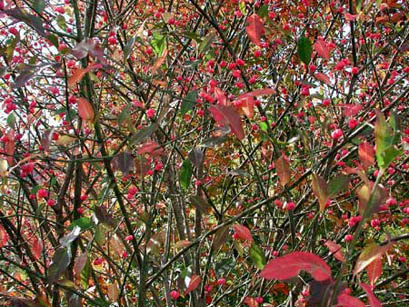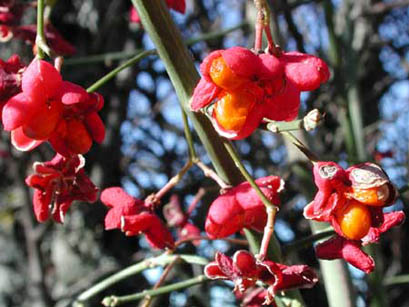Nome comune: fusaggine, berretta del prete, corallini
Specie: Euonymus europaeus L.
Famiglia: CELASTRACEAE
Pianta da cespugliosa ad arbustiva, può raggiungere anche i 3 m di altezza.
Ha fusti a sezione quadrangolare, con foglie lanceolate, opposte, a margine finemente seghettato ed apice molto appuntito.
- I fiori sono piccoli e bianco-verdastri a quattro petali, con odore un po’ sgradevole, riuniti in infiorescenze che si sviluppano a partire dalle ascelle delle foglie.
- Le foglie sono picciolate, opposte, ellittiche o lanceolate a margine finemente dentato. Il colore della pagina superiore della foglia è verde scuro, quello della foglia inferiore più chiaro.
- Il frutto è una capsula a quattro lobi, di colore da rosa-arancio a rosso corallo.
- I semi della fusaggine dopo l’apertura del frutto, giunto a maturità, penzolano caratteristicamente nel vuoto appesi a sottili filamenti.
In autunno è inconfondibile per i frutti, di colore rosa-arancio, rosso corallo intenso, dalla caratteristica forma a quattro lobi, che li fa assomigliare al vecchio cappello dei preti (da cui il nome popolare).
Tossicità
La letteratura del settore indica che praticamente tutte le specie del genere Euonymus sono velenose.
I componenti tossici sono presenti nella corteccia, nelle foglie e nei frutti.
Questi, per il loro colore particolarmente attraente, rosa-arancio, rosso corallo intenso, sono notevolmente invitanti per i bambini, per i quali l’ingestione può rivelarsi anche mortale.
Cavalli, pecore e capre che bruchino le foglie di fusaggine possono parimenti rimanere avvelenati.
I primi sintomi dell’intossicazione compaiono 12-16 ore dopo l’ingestione.
In passato la polvere ricavata dai coloratissimi frutti, fatti essiccare, veniva utilizzata contro la scabbia e anche come insetticida contro i pidocchi.
I semi della fusaggine sono appetiti dagli uccelli che ne sono particolarmente ghiotti.
Curiosità
Il nome popolare di fusaggine deriva dall’utilizzo del legno del fusto di questo arbusto per costruire i fusi per filare la lana.
I giovani fusti, inoltre, sono particolarmente elastici e per questo sono stati utilizzati anche per costruire archi.
 Link da Actaplantarum: Euonymus europaeus
Link da Actaplantarum: Euonymus europaeus
Contents
Euonymus europaeus
| Euonymus europaeus | |
|---|---|

| |
| Scientific classification | |
| Kingdom: | Plantae |
| Clade: | Tracheophytes |
| Clade: | Angiosperms |
| Clade: | Eudicots |
| Clade: | Rosids |
| Order: | Celastrales |
| Family: | Celastraceae |
| Genus: | Euonymus |
| Species: | E. europaeus
|
| Binomial name | |
| Euonymus europaeus | |

| |
| Distribution map | |
| Synonyms[1] | |
|
List
| |
Euonymus europaeus, the spindle, European spindle, or common spindle, is a species of flowering plant in the family Celastraceae, native to much of Europe, where it inhabits the edges of forest, hedges and gentle slopes, tending to thrive on nutrient-rich, chalky and salt-poor soils. It is a deciduous shrub or small tree.
Description
Euonymus europaeus grows to 3–6 m (10–20 ft) tall, rarely 10 m (33 ft), with a stem up to 20 cm (8 in) in diameter. The leaves are opposite, lanceolate to elliptical, 3–8 cm long and 1–3 cm broad, with a finely serrated edge. Leaves are dark green in summer. Autumn colour ranges from yellow-green to reddish-purple, depending on environmental conditions.[2]
The hermaphrodite flowers are produced in late spring and are insect-pollinated; they are rather inconspicuous, small, yellowish green and grow in cymes of 3–8 together. The capsular fruit ripens in autumn, and is red to purple or pink in colour and approximately 1–1.5 cm wide. When ripe, the four lobes split open to reveal the orange seeds.
Habitat and ecology
E. europaeus occurs as an understory shrub or small tree primarily in old hedgerows, open woodland clearings and margins, and scrubland on base-rich or calcareous soils, although it is also shade-tolerant. It rarely invades open habitats such as grasslands except in the presence of abundant hedges[3] In Ireland, it can also be found growing on rocky limestone outcrops, rocky lake shores and limestone pavements.[4]
It is typical in Fraxinus excelsior – Acer campestre – Mercurialis perennis woodland (W8), and it is a frequent companion of Cornus sanguinea in open-stand scrub over limestone, generally in low frequency and abundance throughout.[5] It is usually scattered in distribution but may occasionally occur remarkably commonly on a local scale, such as in the so-called "Spindle Valley" in the Chilterns.[6] The scattered distribution is likely limited by dispersal of seeds via birds and rodents.[7]
E. europaeus is the almost exclusive winter host of the black bean aphid.[8] Because of the potential economic loss from this insect that feeds on cultivated broad beans and sugar beet, spindle in the past was commonly removed from hedges and woodlands as a measure against black bean aphid outbreaks and agricultural yield losses, although this widespread removal does not appear to have impacted current populations. In 1944, The Biology War Committee also began a campaign to investigate the distribution and ecology of E. europeaus as a basis for aphid control measures.[3]
Cultivation and uses
It is a popular ornamental plant in gardens and parks due to its bright pink or purple fruits and attractive autumn colouring.
In cultivation in the UK, the cultivar 'Red Cascade' has gained the Royal Horticultural Society's Award of Garden Merit.[9][10]
European spindle wood is very hard, and can be cut to a sharp point; it was used in the past for making spindles for wool-spinning and for butchers' skewers.[11]
Charcoal produced from this plant is seen as superior among artists due to its strength and density.
Parts of the plant have been used medicinally.[12] However, the fruit is poisonous, containing, amongst other substances, the alkaloids theobromine and caffeine, as well as a large number of much more toxic substances, including cardiac glycosides, and an extremely bitter terpene. Poisonings are more common in young children, who are enticed by the brightly coloured fruits. Ingestion can result in liver and kidney damage and even death.[13]
Gallery
-
1885 illustration by Otto Wilhelm Thomé
-
Whole plant in autumn with leaves and fruits
-
Flower with the four petals and four stamens
-
Fruits
-
Close-up of a fruit
-
Leaf
-
Alpine habitus of a very old specimen
References
- ^ "Tela Botánica". Archived from the original on 2012-03-29. Retrieved 2011-09-06.
- ^ Dirr, Michael A. 1998. Manual of Woody Landscape Plants, 5th ed
- ^ a b Thomas, Peter A.; El-Barghathi, M.; Polwart, A. (2011). "Biological Flora of the British Isles: Euonymus europaeus L." Journal of Ecology. 99 (1): 345–365. Bibcode:2011JEcol..99..345T. doi:10.1111/j.1365-2745.2010.01760.x. S2CID 86183760.
- ^ Green P. 2008. Flora of County Waterford. National Botanic Gardens of Ireland, Dublin, Ireland.
- ^ Rodwell JS. 1991. British Plant Communities. Vol. 1. Woodlands and Scrub. Cambridge University Press, Cambridge, UK
- ^ Snow B, Snow D. 1988. Birds and Berries. Poyser, Calton, UK.
- ^ Grubb, Peter J.; Lee, William G.; Kollmann, Johannes; Wilson, J. Bastow (1996). "Interaction of Irradiance and Soil Nutrient Supply on Growth of Seedlings of Ten European Tall-Shrub Species and Fagus Sylvatica". Journal of Ecology. 84 (6): 827–840. Bibcode:1996JEcol..84..827G. doi:10.2307/2960555. JSTOR 2960555.
- ^ Way, M. J.; Cammell, M. E. (1982). "The Distribution and Abundance of the Spindle Tree, Euonymus europaeus, in Southern England with Particular Reference to Forecasting Infestations of the Black Bean Aphid, Aphis fabae". Journal of Applied Ecology. 19 (3): 929–940. Bibcode:1982JApEc..19..929W. doi:10.2307/2403294. JSTOR 2403294.
- ^ "Euonymus europaeus 'Red Cascade' AGM". Royal Horticultural Society. Retrieved 23 June 2020.
- ^ "AGM Plants - Ornamental" (PDF). Royal Horticultural Society. July 2017. p. 37. Retrieved 20 February 2018.
- ^ Clapham, A. R. (1975). The Oxford Book of Trees. Oxford: Oxford University Press. p.31.
- ^ Plants for a Future: Euonymus europaeus
- ^ "Beware the poisonous autumn berries!". Fat Hen The Wild Cookery School. October 2011. Retrieved 15 September 2020.
External links
- "Spindle Wood (Euonymus Europaeus, L.)". British Wild Flowers. Chest of Books. 2009. Retrieved 2009-09-24.
- "Euonymus europaeus L. - European spindletree". Natural Resources Conservation Service. US Department of Agriculture. 2009. Archived from the original on 2013-05-04.
- "Euonymus europaeus - European Euonymus - Celastraceae". University of Connecticut Plant Database. University of Connecticut. Archived from the original on 2009-03-30. Retrieved 2009-09-24.













